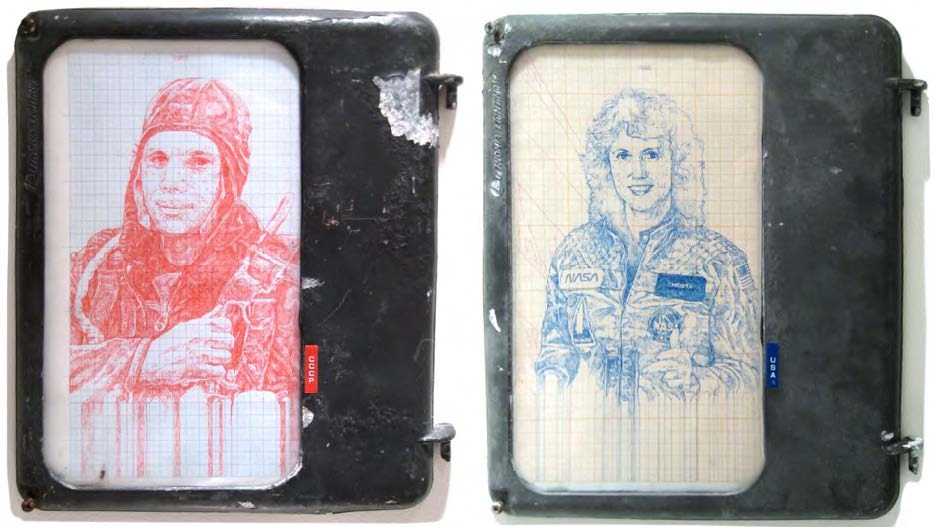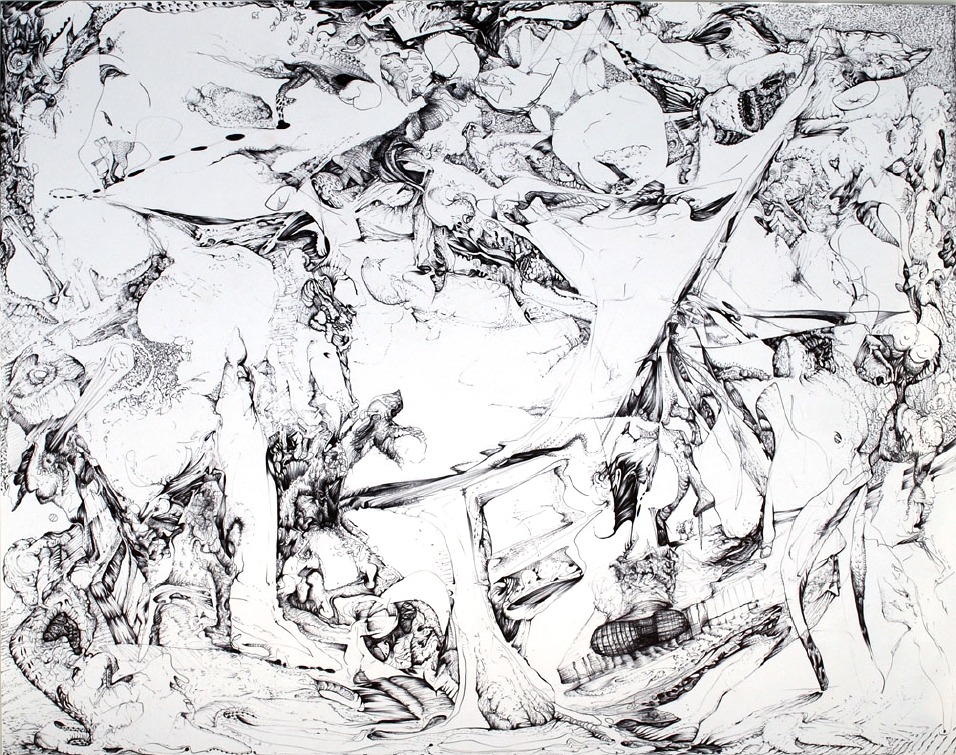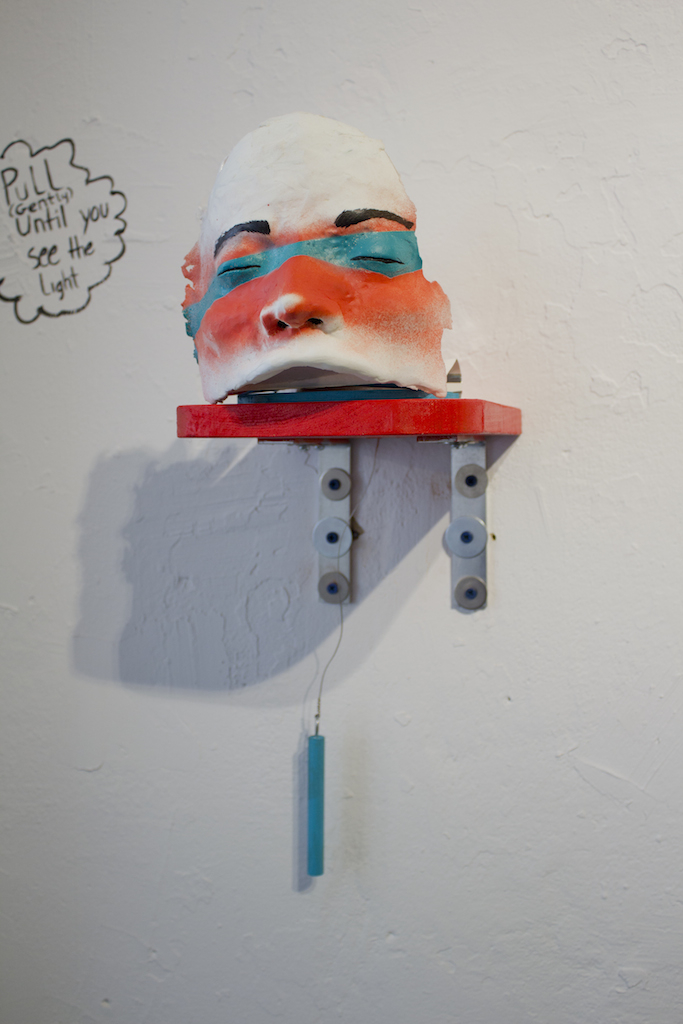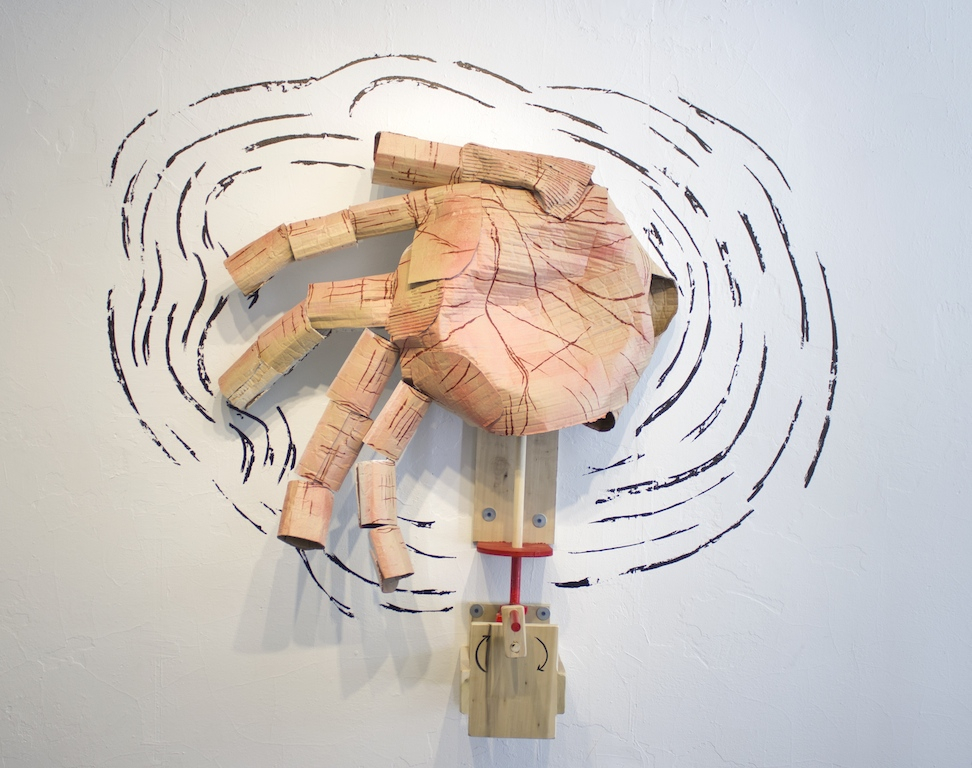2013-15 STUDIO Residents
Lucha Rodriguez: mixed media artist, Nick Madden: mixed media artist, Fatimah Abdullah: animator, Matt Terrel, Angus Galloway: painter, Molly Rose Freeman: painter, muralist, Jason Kofke: printmaker, mixed media artist (not pictured).
ARTIST STAtements & Porfolios
(click thumbnails to view full size images )
The way we move and shape our environment shifts with perceptions and archetypes over time. Gait gives way to character, collective desires transform our landscape, the future is built and relics destroyed by the movements of progression. Smooth, rich patterns in nature develop over millennia, yet human interactions leave fleeting, aggressive marks. When I work, I envision such transitions and patterns and attempt to capture these opposing forces and the liminal places they create.
As an exercise to understand individual elements that make up a greater pattern, I sketch architecture, fabric, textures, and tools from my own surroundings and recreate them as hand-craft cutouts, photocopies and line drawings to manipulate and shoot. Transitions and patterns are discovered in the editing processing as I experiment with automation and layers to find unexpected combinations and displacement, adding nuanced complexities that mimic the organic creation of the nature world
In my work, I use pattern as a lens to explore the dynamic framework of interconnectivity. With a basis of freehand drawing, I build diverse compositions using triangular forms. In expressing mathematical functions with the crooked, imperfect lines my hand makes, I find resonance with the expression of geometry in the crooked imperfection of nature. By using the structure of the triangle—the most basic shape in visual language—I can explore the rhythms and relationships that exist from the microscopic scale to the galactic.
I study patterns both man made—Ottoman mosaics, French Gothic cathedrals, illuminated manuscripts—and natural—wind maps, cell structures, migration patterns, astronomical charts. The effects of visual patterns on the human brain holds a special fascination for me. This has been studied in psychology using techniques like hypnosis and Eye Movement Desensitization and Reprogramming, and it has been used to create feelings of heightened spirituality in sacred objects and spaces throughout the world. The contemplative, emotionally-charged atmospheres invoked by the ubiquitous patterns of sacred architecture, in particular, sparked my desire to paint large-scale murals. I am interested in how the principles of geometry and repetition can be used to create similar spaces of heightened consciousness within the urban landscape. When I create public works, I try to find the distinctive pulse of each specific space in the service of activating its spiritually transformative properties.
My approach to color is mostly intuitive—taking cues from the surrounding landscape to inform the palette of the mural—but it has tended toward vibrant, pulsating colors. I am especially drawn to the combination of red and blue, and the visual vibrations created when they are placed next to each other. Staying true to the inspiration I draw from nature and movement, I look for colors that charge the patterns with an added sense of life—a heartbeat to animate the static form.
Within the visual lexicon of symbols, texts, and media that creates our concept of reality, my work is an attempt to attribute meaning to events of the recent past or imminent future. Using a practice of salvage ethnography, I utilize the things through which events and meanings are communicated: The projection screen in the classroom, the notebook page in the library, the snap shot at the crime scene, the satellite transmission into the living room, the digitized image archive; these devices and their content fabricate our concept of meaning and progress. So as to discern meaning for my viewers or for myself, my work is a manipulation of these communication media and their symbols. I convey images of grand human ambition and catastrophic failure, vanguard technology and moribund devices. I attempt to show relations between events and products, histories and artifacts, images and meanings. The images depicted are titled ‘Everything Will Be OK.’ This is a polarizing statement that reveals to the viewer her immediate emotional bias to reality.
Within my work, I convey notions of Catastrophe Theory – a debunked mathematical study of sudden change. I use a failed theory to objectively understand what I claim are failures of humanity in previous generations: The Nuclear Program, the Cold War, Global Consumerism, Racist Ideologies, Radical Industrialization. I translate these cultural progressions into line-based, scientific illustration style renderings. I exhibit these symbols so as to keep alive their historical relevance and bring greater purpose to choices made in the present.
Conscious of the unprecedented forces invented or discovered in the past century, Santayana's quotation of having to re-live history, should one become ignorant of it, is too ominous a prospect to chance. My use of media as an artist in the early 21st century thus looks backward in time so as to affect our future century.
The artist is an educator and avid promoter of critical thinking, fighting against the passive acceptance of the mainstream and biased media information. We are responsible for cultural integration within society by sparking knowledge in others. Art only exists with the exchange of ideas and experiences others get from it. We are responsible for enriching people through our artwork and help them take ownership of their reactions and feelings towards art, inspiring them to experience and determine their individual perspective on life.
I strongly believe that an artist is someone who is more interested in the idea or concept itself which could be materialized in many ways or simply remain inside people’s minds creating an art of questioning. Critical thinking and the ability to conceive a strong artistic identity are key elements in the creation of art.
My work takes many shapes, forms and scales ranging from etchings, monoprints, serigraphies, to immersive surreal environments, murals and sculptures. The aim of these projects is to explore the various definitions and conceptions of the “internal” not only as related to the human body but also it’s relationship to the mind. It defines and constructs a place for meditation, creativity and self-examination, all actions encompassing private dialogue that claims the body as an intimate private space. These individualistic experiences of accepting and comprehending personal segments of reality when successfully expressed, can contribute to others understanding of their very own perspectives by enriching their cognition of “self” and consequently motivate them to express it.
I focus on developing innovative approaches to new and traditional media. Every creative investigation I have embarked upon has informed the ideas that have come after it. Working with sound informed my understanding of landscape and changed how I approached drawing. I developed the Left Right series by using both hands simultaneously to make marks on the paper. This partnership between my two hands was a direct response to listening intensively with both ears. Because I was not completely in control of both hands I was inviting marks onto the paper that I did not intentionally position. Gradually, with experience, drawing with both hands became a process that I could control. I was no longer surprised by the marks that resulted from using my left hand. I needed to undertake a new process that would lead my work in a fresh and innovative direction.
Art is not just about expressing ideas. It is also about pushing the materials, the surfaces, and the mark. Drawing is the visual result of a physical action; I use this basic idea as the premise to forge a dialogue between the implement in my hand and the paper. My next major series, Findings, does not have a defined figurative subject. Rather, I look into the paper and the sketch of a loose unresolved pattern to trigger the growth of new forms. I have implemented a “window technique” whereby I cover up the drawing and only work inside one small area at a time. My full attention is focused on one part of the drawing. I repeat this process by moving the window and alternating the shape and size of the cutout window. The drawing is finished when the different moments in the work become connected and absorbed by each other—a completed network of events.
I create work based on the notion that materials discarded by most of society deserve a new life. Chunks of wood, rusty nails, used pencils, cardboard, broken furniture, and scrap metal all have a way of mixing and mingling with paint, paper, plaster, and clay in my work to create large collages of messy beauty. The images I create convey a mood rather than make a statement. The idea that art can and should be imperfect, rough around the edges, emotional, both happy and a bit sad plays a large role in my work. When creating art, I prefer to play the part of a weird mystic who is compelled to bang strange materials together, not over thinking anything, trying to make sense of the world around me. Where do people go when they die? Why did the Native Americans of the Southwest decide to carve symbols into desert rocks? Mountains. Have you ever just sat and thought about a mountain? Does different colored light really shine off of us? What would that look like? I'm trying to figure it all out.




































































